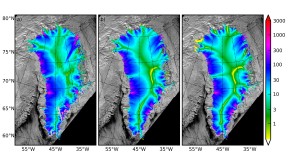UAF researchers poised to gain international partnerships
July 11, 2012

907-474-5229
7/11/12
When a small team of glaciologists and mathematicians at the University of Alaska Fairbanks Geophysical Institute developed the Parallel Ice Sheet Model in 2003, they had no idea that the software program would rise to international prominence.
They created the model, commonly referred to as PISM, in an effort to better understand the physics of ice sheets, whose flow is difficult to observe in the field. Researchers incorporated ice physics, the effects of snow, air temperature, ocean temperature and other environmental influences into the program and then offered it free to the world.
“We made it available for public use and we documented it well,” said Ed Bueler, an associate professor of mathematics at UAF and a member of the Geophysical Institute glaciers group. The model’s accessibility, improved physics and ability to look at large ice sheets at a high resolution attracted the attention of institutions in Germany, Denmark and the Netherlands. Now those users are helping to improve the model.
Since 2003, PISM has undergone several upgrades to better model specific ice sheet behaviors, which has added to its popularity. Notably, researchers at the Potsdam Institute for Climate Impact Research in Germany improved how the model tracks ice shelves and the behaviors of floating ice. For scientists tracking the floating ice shelves of Antarctica—some as big as California—the model forecasts the effects of rising ocean temperatures.
The programming additions made by Potsdam researchers highlight the program’s wide range of adaptability and reinforce the benefits of making it widely available.
“Having more international users and co-developers is a step in the right direction,” said Bueler, who recently returned from the first European PISM Workshop in Germany. The technical conference was hosted at the Max Planck Institute for Meteorology in Hamburg.
ADDITIONAL CONTACTS: Amy Hartley, Geophysical Institute information officer, 907-474-5823, amy.hartley@gi.alaska.edu. Ed Bueler, associate professor, 907-474-7199, elbueler@alaska.edu.
ON THE WEB: www.gi.alaska.edu, http://www.mpimet.mpg.de/en/wissenschaft/ozean-im-erdsystem/euro-pism-workshop
SS/7-11-12/008-13


